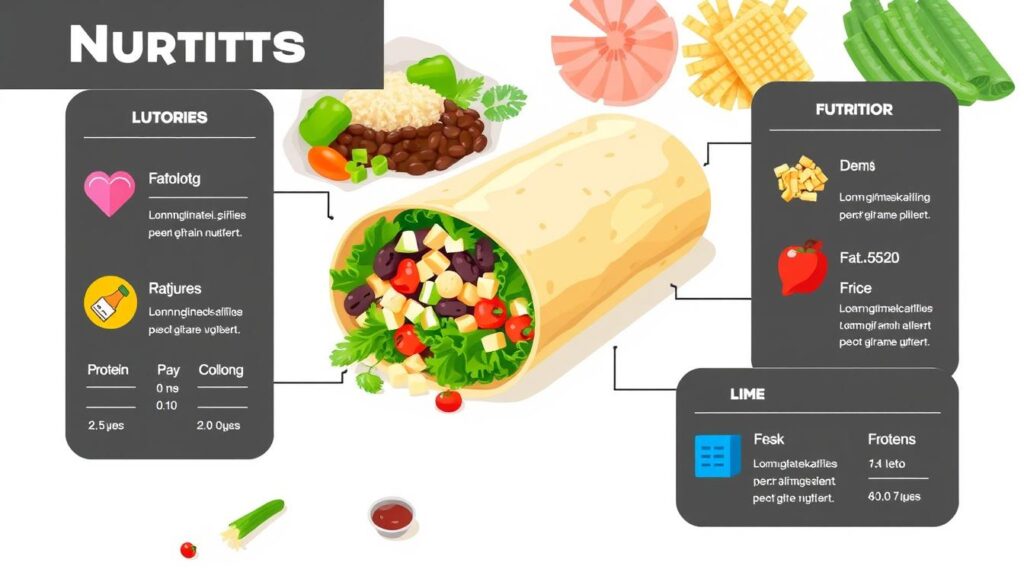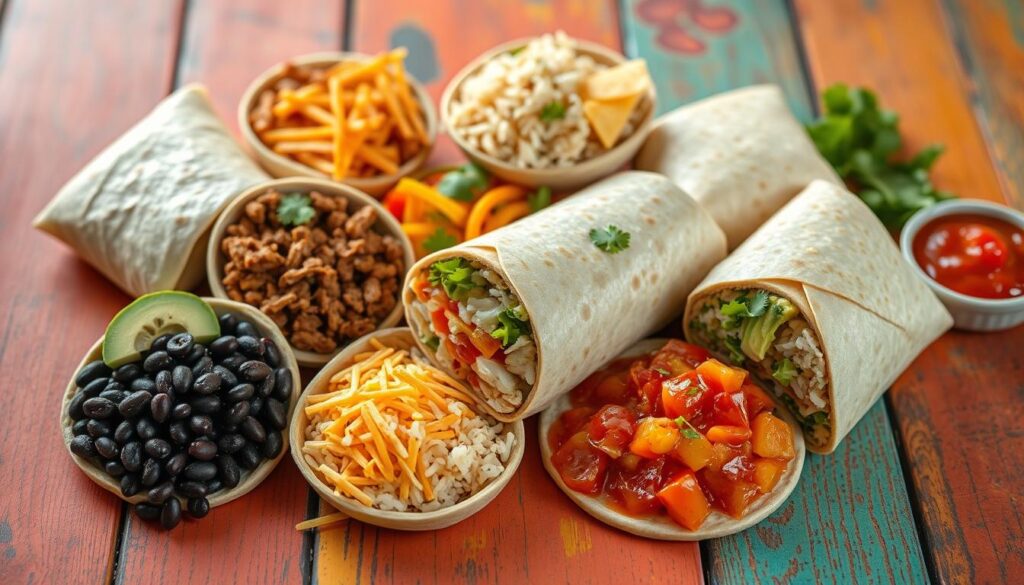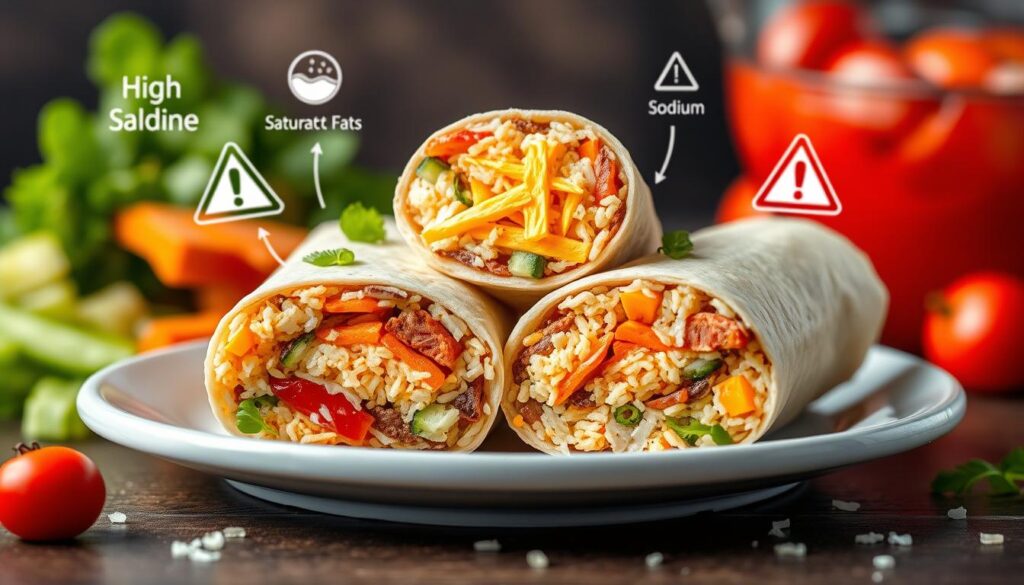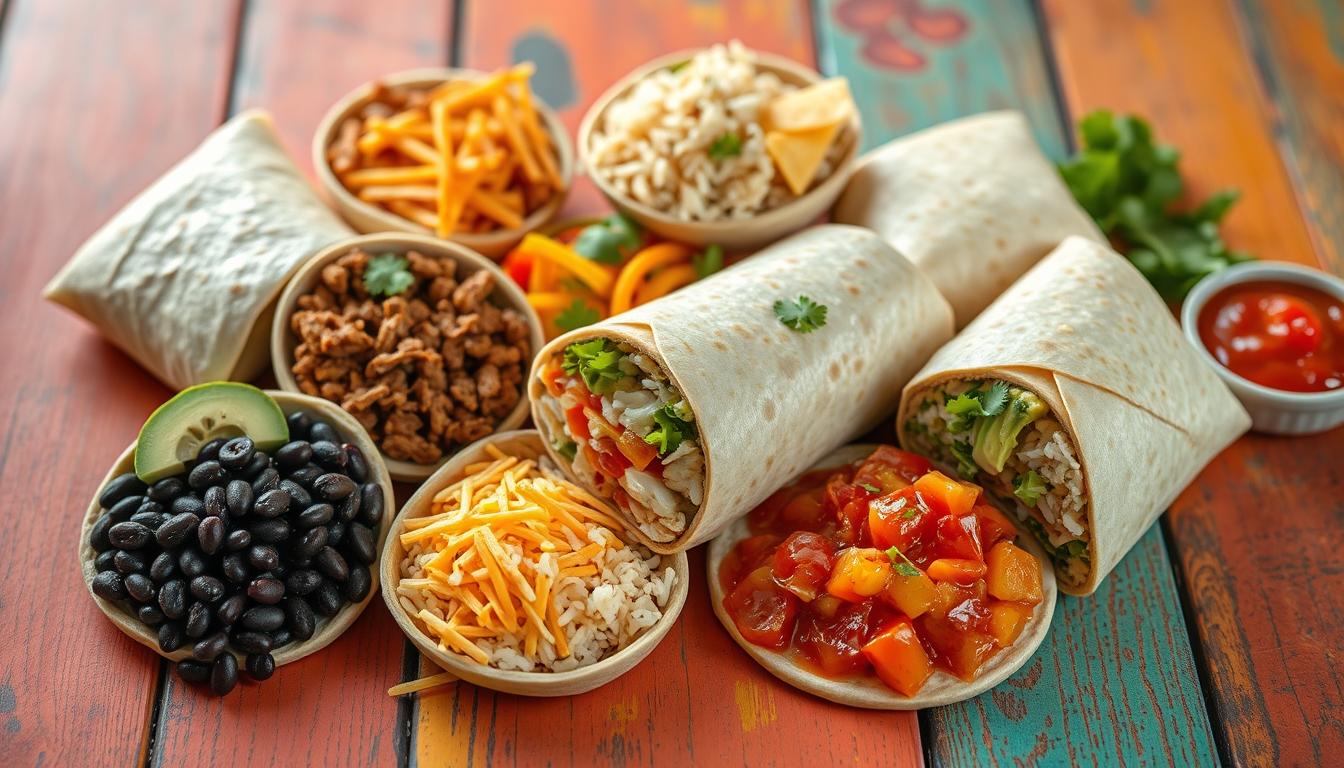
Exploring burrito calories opens up a world of nutrition. Your go-to meal can have 300 to 800 calories, based on what’s inside. Knowing what’s in your burrito helps you eat better while still enjoying it.
The number of calories in a burrito changes a lot. It depends on the protein, tortilla size, and toppings. For example, a chicken burrito has about 380 calories. But a beef burrito can have up to 650 calories. It’s not just about calories; it’s about the mix of nutrients too.
Key Takeaways
- Burrito calories range from 300 to 800 depending on ingredients
- Protein type significantly impacts nutritional content
- Tortilla size affects overall calorie count
- Different fillings create substantial nutritional variations
- Homemade burritos offer more control over nutritional value
Understanding Basic Burrito Components and Origins
Burritos are a tasty trip through Mexican food, starting in Northwestern Mexico. They’ve grown from simple dishes to favorites in North America. This journey is filled with flavors and traditions.
The tale of burritos starts in the early 1900s in Sonora, Mexico. Workers there needed easy-to-carry meals. For thousands of years, Mesoamerican cultures used tortillas as food wraps.
Traditional Mexican vs Modern American Burritos
Mexican burritos and American ones are quite different. In Northern Mexico, burritos were simple, with:
- One or two ingredients
- Smaller sizes
- Clear flavors
American burritos, like the Mission burrito from San Francisco, are bigger and more complex.
Common Ingredients and Their Role
Burrito ingredients are key to their taste and health benefits. Here’s a look at what’s inside:
| Ingredient Category | Common Options | Nutritional Contribution |
|---|---|---|
| Protein | Chicken, Beef | Muscle building, energy |
| Beans | Black beans, Refried pinto beans | Fiber, plant-based protein |
| Extras | Avocado, Salsa | Healthy fats, vitamins |
The story of burritos shows how cultures and cooking styles meet. They’ve changed from a worker’s meal to a worldwide favorite.
Average Calorie Content in Different Types of Burritos
Knowing the calorie count of various burritos helps you choose better. Each type of burrito has its own calorie level. The ingredients used greatly affect the nutritional value.
Exploring different burritos shows big calorie differences. Here are some common ones:
- Beef and Cheese Burrito: About 500 calories
- Bean and Cheese Burrito: Around 380 calories
- Chicken Burrito: Usually 450-600 calories
- Vegetarian Burrito: Often 350-500 calories
Comparing calories can give you interesting health insights. For example, a beef and cheese burrito (190 grams) has a lot of nutrients:
| Nutrient | Amount | % Daily Value |
|---|---|---|
| Protein | 25g | 50% |
| Fat | 20g | 30% |
| Carbohydrates | 54g | 20% |
When picking a burrito, think about more than just calories. Different fillings greatly affect your meal’s health benefits.
“Not all burritos are created equal – ingredients make all the difference!” – Nutrition Expert
A bean and cheese burrito is a lighter choice. It has less fat and more fiber. Knowing these details helps you make better food choices that fit your health goals.
Breaking Down the Nutritional Profile of a Standard Burrito
Knowing the burrito nutrition facts helps you make better food choices. A standard burrito has a mix of nutrients that meet your daily needs.
Macronutrient Distribution
Macronutrients are key in a burrito’s nutrition. They include:
- Protein: 20-40 grams per serving
- Carbohydrates: About 23 grams per 100g
- Total Fat: Around 9 grams per 100g
Micronutrient Content
Burritos also have vitamins and minerals. The type and amount depend on what’s inside, like veggies, meats, and beans.
| Nutrient | Amount per 100g | % Daily Value |
|---|---|---|
| Sodium | 565 mg | 24.57% |
| Fiber | 3 g | 10.71% |
| Protein | 8 g | 16% |
Sodium and Fiber Levels
Be careful with sodium and fiber in burritos. A single burrito has about 565 mg of sodium, almost 25% of what you should have daily.
“Choose wisely: Your burrito can be a nutritional ally or a dietary challenge.”
To get the most nutrition, pick whole grain tortillas, lean proteins, and lots of veggies. These choices let you enjoy a tasty burrito while keeping your diet balanced.
Beef and Cheese Burrito Nutrition Facts
Beef burritos are more than just tasty; they’re packed with nutrients. A 190-gram burrito is a powerhouse of protein and vitamins. It’s a great way to meet your daily nutritional needs.
The protein in a beef burrito is a big plus. With 25 grams per serving, it helps keep muscles strong and keeps you full. This makes beef burritos a great choice for a filling, nutritious meal.
“A beef burrito isn’t just a tasty meal, it’s a nutrient powerhouse that can contribute to your daily nutritional requirements.” – Nutrition Experts
Detailed Nutritional Breakdown
| Nutrient | Amount | Daily Value % |
|---|---|---|
| Protein | 25g | 50% |
| Fat | 20g | 30% |
| Carbohydrates | 54g | 20% |
| Sodium | 902mg | 39% |
Knowing the calories in a beef burrito helps you choose better. It’s rich in important nutrients:
- Vitamin B12: 63% of daily value
- Iron: 29% of daily value
- Niacin: 48% of daily value
- Folate: 27% of daily value
Remember, while beef burritos are nutritious, eating them in moderation is important. They have a lot of sodium and fat.
Bean and Cheese Burrito Calorie Analysis
Learning about the nutritional value of a bean and cheese burrito is key to making good food choices. These tasty wraps offer more than just great taste. They are packed with nutrients.
Protein and Fiber Content
Bean burritos are high in protein and fiber. A serving has about 22 grams of protein, which is great for muscles. They also have around 5 grams of fiber, which is good for your digestion and keeps you full.
- Protein supports muscle development
- Fiber aids digestive wellness
- Helps maintain steady energy levels
Vitamin and Mineral Profile
Bean burritos are not just about protein and fiber. They also have important vitamins and minerals. They are rich in calcium, iron, and vitamin D. This makes them a nutritious choice for a meal.
| Nutrient | Amount | % Daily Value |
|---|---|---|
| Calcium | 370mg | 28% |
| Iron | 3.20mg | 18% |
| Vitamin D | 2mcg | 10% |
Understanding the nutritional value of a bean burrito shows how it can be a smart choice for a healthy diet. It’s a mix of protein, fiber, and important nutrients. This makes it a great option for those who care about their health.
Impact of Different Fillings on Calorie Count
When making your perfect burrito, knowing how fillings affect calories is key. The ingredients you pick can change your meal’s nutrition a lot.

Guacamole, sour cream, and extra cheese add a lot of calories. Here’s how they change your meal’s nutrition:
- Guacamole: Adds about 50-100 calories
- Sour cream: Adds 50-75 calories
- Extra cheese: Adds 80-120 calories
- Rice: Adds about 200 calories per serving
Beans and lean meats are good for you and keep calories in check. Here are some protein-rich options:
| Protein Source | Calories | Protein Content |
|---|---|---|
| Black Beans | 114 calories per 1/2 cup | 7-8g protein |
| Grilled Chicken | 140 calories per serving | 26g protein |
| Tofu | 94 calories per 1/2 cup | 10g protein |
Pro tip: Pick your burrito fillings wisely to get flavor, nutrition, and control calories.
“Not all calories are created equal – focus on nutrient-dense ingredients for a healthier burrito experience.”
Understanding how fillings affect calories lets you make a meal that’s good for you and tastes great.
Health Benefits of Consuming Burritos
Burritos are more than just tasty food. They can be a healthy choice if made right. Knowing the health perks of burritos helps you pick better foods and enjoy a full meal.
A good burrito packs many nutrients into one dish. It’s a chance to get all the nutrients you need in one go. This makes it a great way to support your health.
Complete Meal Advantages
Make your burrito a balanced meal with smart choices. Here are some key benefits:
- Protein from lean meats or beans
- Complex carbohydrates from whole grain tortillas
- Vegetables for added vitamins and minerals
- Healthy fats from avocado or olive oil
Essential Nutrients in Every Bite
Choosing the right ingredients makes a burrito very nutritious. Here’s what you can get:
| Nutrient | Typical Contribution | Health Impact |
|---|---|---|
| Protein | 20g per serving | Muscle repair and growth |
| Fiber | 2-4g per serving | Digestive health support |
| Iron | 10-15% daily value | Blood oxygen transportation |
“A burrito can be a nutritional treasure when you’re mindful of your ingredients.” – Nutritional Expert
Choosing quality ingredients and controlling portions turns a simple burrito into a healthy meal. Your choices are key. Go for whole foods, lean proteins, and lots of veggies to get the most health benefits.
Potential Health Considerations and Drawbacks

Burritos can pose health risks you should know about. These risks go beyond just counting calories. They involve complex nutritional concerns.
Sodium content is a big health concern. A single burrito can have a lot of salt. This can be more than half of what the American Heart Association suggests you eat in a day.
- High sodium levels can contribute to blood pressure issues
- Excessive salt intake may increase risk of cardiovascular problems
- Processed ingredients amplify potential health risks
Saturated fat is another big worry. Burritos with cheese, sour cream, and fatty meats can raise your saturated fat intake a lot. One tablespoon of sour cream contains 1.5 grams of saturated fat, which adds up fast in a burrito.
| Nutritional Component | Potential Health Impact |
|---|---|
| Sodium | Increased blood pressure risk |
| Saturated Fat | Higher cholesterol levels |
| Processed Ingredients | Reduced nutrient density |
“Your food choices directly impact your long-term health. Understanding the potential risks is the first step to making informed dietary decisions.” – Nutritional Expert
While burritos can be part of a healthy diet, it’s important to choose wisely. Opt for lean proteins, whole grain tortillas, and add lots of veggies. This can help reduce health risks.
Making Healthier Burrito Choices
Creating tasty low-calorie burritos doesn’t mean you have to give up flavor or enjoyment. By choosing the right ingredients and controlling portions, you can make this classic dish healthier. This way, it supports your health goals.
Smart Ingredient Substitutions
When making healthy burritos, focus on swapping ingredients to cut calories and boost nutrition:
- Replace white tortillas with whole wheat or sprouted grain tortillas
- Choose lean proteins like grilled chicken or black beans
- Add more vegetables for fiber and nutrients
- Use Greek yogurt instead of sour cream
- Opt for low-fat cheese
Portion Control Strategies
It’s important to control the size of your burrito for a balanced diet. Here are some tips for making low-calorie burritos:
- Use smaller tortillas (6-inch instead of 8-inch)
- Measure ingredients carefully
- Fill half the tortilla with vegetables
- Split a large burrito into two meals
“Eating mindfully isn’t about restriction, but about making informed choices that nourish your body.”
By using these strategies, you can enjoy burritos that are both tasty and healthy. Remember, small changes can lead to big improvements in your health and wellness.
Restaurant vs Homemade Burrito Nutrition Comparison
Restaurant burritos usually have a lot more calories, often over 1,000 per serving. Homemade burritos let you control what goes in and how much. This way, you can make them healthier.
There are big differences in what restaurant and homemade burritos offer:
- Sodium content: Restaurant burritos have more sodium
- Ingredient quality: Homemade burritos use fresher, less processed ingredients
- Portion control: You can control how much you eat with homemade burritos
Looking at the numbers, we see big differences in calories and nutrients:
| Burrito Type | Average Calories | Sodium | Fat Content |
|---|---|---|---|
| Restaurant Burrito | 800-1200 | 1093mg | 14g |
| Homemade Burritos | 500-700 | 450-600mg | 8-10g |
Making your own burritos is a healthier choice. You can pick lean proteins, whole grain tortillas, and control fats. Restaurant burritos often focus on taste over health.
“The secret to a healthy burrito is knowing exactly what goes into it” – Nutrition Expert
By making your own burritos, you can eat less and still enjoy great taste and nutrition.
Conclusion
Understanding burrito nutrition is key to making smart food choices. Your exploration shows that burritos can be part of a healthy diet. It’s all about picking the right ingredients and controlling portion sizes.
Places like Chipotle Mexican Grill and local taquerias have many burrito options. By choosing lean proteins and adding fresh veggies, you can make a meal that’s good for you. Think of burritos as a way to support your health, not just a treat.
National Burrito Day in April reminds us to enjoy burritos wisely. With vegetarian, vegan, and fusion burritos, you can easily add them to a balanced diet. Always keep in mind moderation, knowing what you eat, and your own health needs.
Our deep dive into burrito nutrition helps you make better choices. You can now pick wisely from menus, understand what’s in your food, and make meals that fit your health goals. See burritos as a friend on your health journey, not an enemy.
FAQ
How many calories are typically in a burrito?
Burritos can have anywhere from 300 to 1,000 calories. This depends on what’s inside and how big it is. A typical restaurant burrito usually has 500-800 calories.
Things like protein, cheese, rice, and toppings greatly affect the calorie count.
Are burritos considered a healthy meal option?
Burritos can be healthy if made right. Choose lean proteins, whole grain tortillas, and lots of veggies. Making your own burritos lets you control what goes in.
What are the main nutritional components of a typical burrito?
A burrito has protein from meat or beans, carbs from tortillas and rice, and fats from cheese or toppings. It also has important nutrients like iron, folate, and vitamins.
How do different protein choices affect a burrito’s nutrition?
The protein in a burrito changes its nutrition a lot. Beef burritos have more saturated fat and calories. Chicken or bean burritos are leaner.
Vegetarian burritos with beans are high in fiber and have less calories.
What are some ways to make a burrito healthier?
For a healthier burrito, use whole wheat tortillas and lean proteins. Add more veggies and use less cheese. Choose Greek yogurt over sour cream and watch your portion sizes.
Stay away from extra cheese and creamy sauces that add a lot of calories.
How does sodium content vary in different burritos?
Sodium in burritos can be from 600 to 1,500 milligrams. Restaurant and processed burritos usually have more. Ingredients like processed meats, cheese, and sauces add a lot of sodium.
Making your own burritos lets you control the salt.
Are bean burritos a good option for vegetarians?
Yes, bean burritos are great for vegetarians. They have plant-based protein, fiber, and nutrients like folate and iron. They also have fewer calories than meat-based burritos.
How do restaurant burritos differ from homemade versions nutritionally?
Restaurant burritos have bigger portions and more calories. Homemade burritos let you choose better ingredients and control sizes. Making your own can be much healthier.

